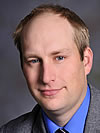
Sterling J. Nesbitt
Virginia Tech
2017 Young Scientist Award (Donath Medal)
Presented to Sterling J. Nesbitt
Citation by Shuhai Xiao
Sterling Nesbitt’s outstanding achievements in vertebrate paleontology have revolutionized the way geoscientists view the beginning of the Age of Dinosaurs and Earth history in general. Sterling’s work centers on environmental evolution and vertebrate radiation after the Permian-Triassic mass extinction, using archosaurs—a group including birds, crocodylians, and dinosaurs—as a model. Through targeted hypothesis-driven fieldwork and elucidation of large-scale patterns in vertebrate history, Sterling has helped reshape our knowledge about macro-evolutionary patterns of diversification, biogeography, disparity, morphology, and convergent evolution. His work has challenged long-standing doctrines and established new paradigms.
Sterling is a talented explorer and has made ground-breaking discoveries around the world, from Argentina to Mongolia. He is also an extraordinary science communicator, teacher, and mentor. Along with Michelle Stocker, Sterling has built one of the most sought-after vertebrate paleontology graduate programs at Virginia Tech. Sterling is highly deserving of the Donath medal.
2017 Donath Medal — Response by Sterling J. Nesbitt
I am completely honored to accept this prestigious award. First of all, I would like to thank Steve Holbrook for inspiration and Shuhai Xiao for nominating me and organizing the letters. Shuhai is an amazing colleague and both Steve Holbrook and Shuhai have been amazing mentors.
Sincerest thanks to my letter writers—Kevin Padian, John Hutchinson, John Flynn, Christian Sidor, and Zhe-Xi Luo. Without their mentorship, support and awe-inspiring conversations, I would not be close to where I am today. Each person has been instrumental into shaping me into a broad geoscientist.
I was extremely fortunate to know that I wanted to become a vertebrate paleontologist since my first “dig” in 1997 in the sweltering heat of the Phoenix basin in July. Robert McCord (Arizona Museum of Natural History) trusted me as a freshman in high school to prep fossils and start to make new observations. He encouraged me to write and a year later, I submitted my first paper.
I am indebted to Kevin Padian for his incredible mentorship. Ever since I showed up at his office door with a box of fossil bones (after a flight and a trip quick on BART), he had convinced me to follow my passion in paleontology at the University of California at Berkeley. A year later, I started in his research lab a week before my freshman year at Berkeley—thank you, Kevin, for giving me a chance. My interactions with friends and colleagues I met through the University of California Museum of Paleontology remain the foundation for my scientific enquiry and outreach. John Hutchinson’s excitement for archosaur anatomy was contagious. As my geology mentor, Walter Alvarez taught me how one “little idea” could change the world.
During my Ph.D. at Columbia, my primary mentors, Paul Olsen and Mark Norell, showed me both sides of paleontology: university and a large museum, through the lens of geosciences and through the lens of biology. Thanks to Paul, I will never venture to far from the Triassic Period deposits in eastern North America and thanks to Mark, I will always study the rise of carnivorous dinosaurs. Both showed me that I could go anywhere in the world to chase my questions and they encouraged it constantly. John Flynn has shown me the importance of having fun and meeting new people inside and outside the field of paleontology. I am also very grateful to my fellow American Museum of Natural History friends and colleagues, including Amy Davidson, Carl Mehling, Alan Turner, Shaena Montanari, Jack Conrad, Steven Brusatte, Mick Ellison, Dan Ksepka, Amy Balanoff, and Gabe Bever.
My postdoctoral advisors Julia Clarke, Christian Sidor, and Kenneth Angielczyk introduced me to the intricacies, logistics, and excitement of running my own research lab. Each had amazing advice on how to efficiently train students while maintaining a personal research track, and how to smoothly conduct foreign fieldwork.
I was incredibly lucky to start in the Department of Geosciences at Virginia Tech in winter of 2014 and interact with stellar colleagues and undergraduate and graduate students. Particularly, I would like to thank the support of the tenure-track faculty, including Esteban Gazel, Brian Romans, Mark Caddick, Ben Gill, Sarah Stamps, Ryan Pollyea, Michelle Stocker, Marc Michel, and Robert Weiss. I wouldn’t have made it easily through my first few years without the guidance and mentorship of Nancy Ross, Robert Tracy, Shuhai Xiao, James Spotila, Robert Bodnar, and Patricia Dove. Thank you to my current and past lab members for showing me the excitement that emanates from research.
I would also like to thank my long-term colleagues and some of my best friends Randall Irmis, Alan Turner, Nathan Smith, and William Parker. I would be lost without you all!
I thank my father, Jim Nesbitt, who showed me Earth from 10,000 feet and my mother, Noreen Nesbitt, whose curiosity for nature and the fossil record kept me grounded. My sister, Casey Luchessi, is always supportive in my exploration of the world.
My partner and closest colleague, Michelle Stocker, is my rock and encouragement. We are on a lifetime journey together, whether in the past, present, or future. Our scientist in training, 16-month-old Avett, has shown me that there is far more in this life than old bones in the ground.
Thank you Donath family and thank you GSA.
